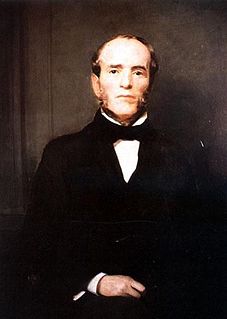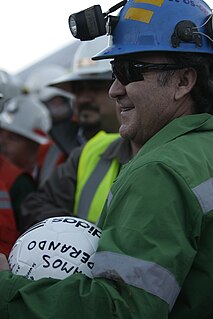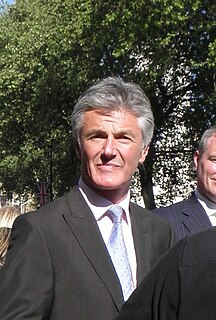Related Research Articles

The Atacama Region is one of Chile's 16 first order administrative divisions. It comprises three provinces: Chañaral, Copiapó and Huasco. It is bordered to the north by Antofagasta, to the south by Coquimbo, to east with Provinces of Catamarca, La Rioja and San Juan of Argentina, and to the west by the Pacific Ocean. The regional capital Copiapó is located at 806 km (501 mi) north of the country's capital of Santiago. The region occupies the southern portion of the Atacama Desert, the rest of the desert is mainly distributed among the other regions of Norte Grande.

Copiapó is a city in northern Chile, located about 65 kilometers east of the coastal town of Caldera. Founded on December 8, 1744, it is the capital of Copiapó Province and Atacama Region.

Caldera is a port city and commune in the Copiapó Province of the Atacama Region in northern Chile. It has a harbor protected by breakwaters, being the port city for the productive mining district centering on Copiapó to which it is connected by the first railroad constructed in Chile.

Ramón Allende Padín, nicknamed El Rojo, was a Chilean physician and political figure. The author of several important scientific publications, he also headed the Chilean Army's medical services during the War of the Pacific. Allende was of Basque descent.

Matías Cousiño Jorquera (1810–1863) was a Chilean coal magnate and patriarch of the wealthy Cousiño family. Cousiño's most emblematic coal mine was found in Lota a small coastal town on the coast of the Bío-Bío Region, where steam ships that crossed the Strait of Magellan could be resupplied with coal.

Chañarcillo is a town and mine in the Atacama Desert of Copiapó Province, Atacama Region, Chile, located near Vallenar and 60 km from Copiapó. It is noted for its silver mining. The town grew up after the Chañarcillo silver mine was discovered on May 16, 1832, by Juan Godoy. This event sparkled the Chilean silver rush. It grew in prominence in the second half of the nineteenth century and became important in the Atacama mining industry and one of the most important mines to the Chilean economy. It was connected by railway before 1862. Today the settlement is largelly in ruins.

The 2010 Copiapó mining accident, also known then as the "Chilean mining accident", began on 5 August 2010, with a cave-in at the San José copper–gold mine, located in the Atacama Desert 45 kilometers (28 mi) north of the regional capital of Copiapó, in northern Chile. Thirty-three men, trapped 700 meters (2,300 ft) underground and 5 kilometers (3 mi) from the mine's entrance via spiraling underground ramps, were rescued after 69 days.

Franklin Erasmo Lobos Ramírez is a retired Chilean footballer. Lobos debuted in 1980 for Regional Atacama, and retired in 1995, playing for the same club he started his career with. He was nicknamed El Mortero Mágico. He eventually became a miner and was one of the miners trapped underground for two months in the 2010 Copiapó mining accident. On October 13, 2010, Lobos was the 27th of 33 miners to be rescued.
Chile mining accident may refer to:

Pedro León Gallo Goyenechea was a Chilean politician and one of the founders of the Radical Party. He was the son of the illustrious mining entrepreneur Miguel Gallo Vergara.

The San José Mine is a small copper-gold mine located near Copiapó, Atacama Region, Chile. The mine became known internationally for its collapse in 2010, which trapped 33 miners 700 metres (2,300 ft) underground. Its workings are reached by a long sloping roadway with many spiral turns, not by a vertical mineshaft.

Timothy Melton Willcox is a British journalist for BBC News. He presents news programmes on BBC World News and the BBC News Channel. He is probably most recognisable for presenting the BBC's live coverage from Chile during events surrounding the Copiapó mining accident and anchoring the BBC's live daytime coverage during the early days of the Cairo January 2011 Egyptian revolution.

Compañía Minera San Esteban Primera is a Chilean mining company, dedicated to the production of copper and gold concentrates. San Esteban's headquarters are located in Providencia, Santiago Metropolitan Region.
Raúl Armando Barrionuevo (1913–1996) was a Chilean farmer and politician. He was born in Copiapó, January 15, 1913. He died in the same city, on May 24, 1996. He was the son of Don Luis Barrionuevo Armando Galindo and his cousin, Maria Luisa Barrionuevo Roldán. He married Naomi Olga Huerta in 1936.

Between 1830 and 1850 Chilean silver mining grew at an unprecedented pace which transformed mining into one of the country's principal sources of wealth. The rush caused rapid demographic, infrastructural, and economic expansion in the semi-arid Norte Chico mountains where the silver deposits lay. A number of Chileans made large fortunes in the rush and made investments in other areas of the economy of Chile. By the 1850s the rush was in decline and lucrative silver mining definitively ended in the 1870s. At the same time mining activity in Chile reoriented to saltpetre operations.

Juan Godoy was a Chilean farmer and miner who in 1832 is said to have discovered an outcrop (reventón) of silver 50 km (31 mi) south of Copiapó in Chañarcillo. This event sparkled the Chilean silver rush.

The 33 is a 2015 English-language biographical disaster-survival drama film directed by Patricia Riggen and written by Mikko Alanne, Craig Borten, Michael Thomas, and José Rivera. The film is based on the real events of the 2010 Copiapó mining disaster, in which a group of thirty-three miners were trapped inside the San José Mine in Chile for 69 days. The film stars Antonio Banderas as trapped miner Mario Sepúlveda.
The following lists events that happened during 2006 in Chile.
During most of Chile's history, from 1500 to the present, mining has been an important economic activity. 16th century mining was oriented towards the exploitation of gold placer deposits using encomienda labour. After a period of decline in the 17th century mining resurged in the 18th and early 19th century this time revolving chiefly around silver. In the 1870s silver mining declined sharply. Chile took over the highly lucrative saltpetre mining districts of Peru and Bolivia in the War of the Pacific (1879–83). In the first half of the 20th century copper mining overshadowed the declining saltpetre mining.
Miguel Gallo Vergara was a Chilean millionaire mining entrepreneur, politician and patriot. He was mayor of Copiapó for the year 1820, and was appointed a Deputy of the Republic of Chile representing Copiapó, Chañaral and Freirina from 1849 to 1852. A pioneer of the silver mining industry in Chile, working with Juan Godoy from 1832, he is still remembered as an illustrious figure in the Atacama mining industry and in the history of Copiapó.
References
- ↑ Figueroa, Pedro Pablo (1901). Diccionario biográfico de Chile (in Spanish). Vol. 3 (4th ed.). Impr. y encuadernacion Barcelona. p. 15. OCLC 6954676.
 This article incorporates text from this source, which is in the public domain .
This article incorporates text from this source, which is in the public domain .